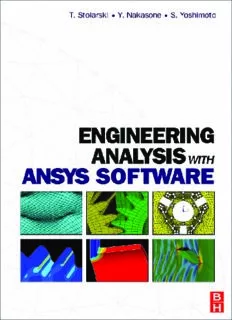
Engineering Analysis with ANSYS Software PDF
Preview Engineering Analysis with ANSYS Software
FM-H6875.tex 28/11/2006 16:7 pagei Engineering Analysis With ANSYS Software This page intentionally left blank FM-H6875.tex 28/11/2006 16:7 pageiii Engineering Analysis With ANSYS Software Y. Nakasone and S. Yoshimoto Department of Mechanical Engineering Tokyo University of Science,Tokyo,Japan T. A. Stolarski Department of Mechanical Engineering School of Engineering and Design Brunel University,Middlesex,UK AMSTERDAM (cid:127) BOSTON (cid:127) HEIDELBERG (cid:127) LONDON (cid:127) NEW YORK (cid:127) OXFORD PARIS (cid:127) SAN DIEGO (cid:127) SAN FRANCISCO (cid:127) SINGAPORE (cid:127) SYDNEY (cid:127) TOKYO Butterworth-Heinemann is an imprint of Elsevier FM-H6875.tex 28/11/2006 16:7 pageiv ElsevierButterworth-Heinemann LinacreHouse,JordanHill,OxfordOX28DP 30CorporateDrive,Burlington,MA01803 Firstpublished2006 Copyright©2006N.Nakasone,T.A.StolarskiandS.Yoshimoto.Allrightsreserved TherightofHowardD.Curtistobeidentifiedastheauthorof thisworkhasbeenassertedinaccordancewiththeCopyright,Designand PatentsAct1988 Nopartofthispublicationmaybereproducedinanymaterialform(including photocopyingorstoringinanymediumbyelectronicmeansandwhetheror nottransientlyorincidentallytosomeotheruseofthispublication)without thewrittenpermissionofthecopyrightholderexceptinaccordancewiththe provisionsoftheCopyright,DesignsandPatentsAct1988orunderthetermsofa licenceissuedbytheCopyrightLicensingAgencyLtd,90TottenhamCourtRoad, London,EnglandW1T4LP.Applicationsforthecopyrightholder’swritten permissiontoreproduceanypartofthispublicationshouldbeaddressedto thepublisher PermissionsmaybesoughtdirectlyfromElsevier’sScience&Technology RightsDepartmentinOxford,UK:phone(+44)1865843830, fax:(+44)1865853333,e-mail:[email protected]. Youmayalsocompleteyourrequeston-lineviatheElsevierhomepage (http://www.elsevier.com),byselecting‘CustomerSupport’andthen ‘ObtainingPermissions’ ThecopyrightedscreenshotsoftheANSYSsoftwaregraphicalinterfacethat appearthroughoutthisbookareusedwithpermissionofANSYS,Inc. ANSYSandanyandallANSYS,Inc.brand,product,serviceandfeaturenames, logosandslogansareregisteredtrademarksortrademarksofANSYS,Inc.or itssubsidiariesintheUnitedStatesorothercountries. BritishLibraryCataloguinginPublicationData AcataloguerecordforthisbookisavailablefromtheBritishLibrary LibraryofCongressCataloguinginPublicationData AcataloguerecordforthisbookisavailablefromtheLibraryofCongress ISBN075066875X ForinformationonallElsevierButterworth-Heinemann publicationsvisitourwebsiteathttp://books.elsevier.com TypesetbyCharonTecLtd(AMacmillanCompany),Chennai,India www.charontec.com PrintedandboundbyMPGBooksLtd.,Bodmin,Cornwall FM-H6875.tex 28/11/2006 16:7 pagev C o n t e n t s Preface xiii The aims and scope of the book xv Ch1apter Basics of finite-element method 1 Methodofweightedresiduals 1.1 2 1.1.1 Sub-domainmethod(Finitevolumemethod) 2 1.1.2 Galerkinmethod 4 Rayleigh–Ritzmethod 1.2 5 Finite-elementmethod 1.3 7 1.3.1 One-elementcase 10 1.3.2 Three-elementcase 11 FEMintwo-dimensionalelastostaticproblems 1.4 14 1.4.1 Elements of finite-element procedures in the analysis of planeelastostaticproblems 15 1.4.2 Fundamentalformulaeinplaneelastostaticproblems 16 1.4.2.1 Equationsofequilibrium 16 1.4.2.2 Strain–displacementrelations 16 1.4.2.3 Stress–strainrelations(constitutiveequations) 17 1.4.2.4 Boundaryconditions 19 1.4.3 Variationalformulaeinelastostaticproblems:theprinciple ofvirtualwork 21 1.4.4 Formulation of the fundamental finite-element equations inplaneelastostaticproblems 21 1.4.4.1 Strain–displacementmatrixor[B]matrix 21 1.4.4.2 Stress–strainmatrixor[D]matrix 25 1.4.4.3 Elementstiffnessequations 25 1.4.4.4 Globalstiffnessequations 27 1.4.4.5 Example:Finite-elementcalculationsforasquare platesubjectedtouniaxialuniformtension 30 Bibliography 34 v FM-H6875.tex 28/11/2006 16:7 pagevi vi Contents Ch2apter Overview of ANSYS structure and visual capabilities 37 Introduction 2.1 37 Startingtheprogram 2.2 38 2.2.1 Preliminaries 38 2.2.2 Savingandrestoringjobs 40 2.2.3 Organizationoffiles 41 2.2.4 Printingandplotting 42 2.2.5 Exitingtheprogram 43 Preprocessingstage 2.3 43 2.3.1 Buildingamodel 43 2.3.1.1 Definingelementtypesandrealconstants 44 2.3.1.2 Definingmaterialproperties 46 2.3.2 Constructionofthemodel 47 2.3.2.1 Creatingthemodelgeometry 47 2.3.2.2 Applyingloads 48 Solutionstage 2.4 49 Postprocessingstage 2.5 50 Ch3apter Application of ANSYS to stress analysis 51 Cantileverbeam 3.1 51 3.1.1 Exampleproblem:Acantileverbeam 52 3.1.2 Problemdescription 53 3.1.2.1 Reviewofthesolutionsobtainedbythe elementarybeamtheory 53 3.1.3 Analyticalprocedures 53 3.1.3.1 Creationofananalyticalmodel 53 3.1.3.2 Inputoftheelasticpropertiesofthebeam material 56 3.1.3.3 Finite-elementdiscretizationofthebeamarea 57 3.1.3.4 Inputofboundaryconditions 62 3.1.3.5 Solutionprocedures 71 3.1.3.6 Graphicalrepresentationoftheresults 73 3.1.4 ComparisonofFEMresultswithexperimentalones 76 3.1.5 Problemstosolve 76 Appendix:Proceduresforcreatingsteppedbeams 80 A3.1 Creationofasteppedbeam 80 A3.1.1 Howtocanceltheselectionofareas 81 A3.2 Creationofasteppedbeamwitharoundedfillet 81 A3.2.1 Howtodisplayareanumbers 84 FM-H6875.tex 28/11/2006 16:7 pagevii Contents vii TheprincipleofSt.Venant 3.2 84 3.2.1 Exampleproblem:Anelasticstripsubjectedtodistributed uniaxialtensilestressornegativepressureatoneend andclampedattheotherend 84 3.2.2 Problemdescription 85 3.2.3 Analyticalprocedures 85 3.2.3.1 Creationofananalyticalmodel 85 3.2.3.2 Inputoftheelasticpropertiesofthestripmaterial 86 3.2.3.3 Finite-elementdiscretizationofthestriparea 86 3.2.3.4 Inputofboundaryconditions 88 3.2.3.5 Solutionprocedures 89 3.2.3.6 Contourplotofstress 92 3.2.4 Discussion 92 Stressconcentrationduetoellipticholes 3.3 93 3.3.1 Exampleproblem: Anelasticplatewithanellipticholein itscentersubjectedtouniformlongitudinaltensilestressσ o atoneendanddampedattheotherend 93 3.3.2 Problemdescription 94 3.3.3 Analyticalprocedures 94 3.3.3.1 Creationofananalyticalmodel 94 3.3.3.2 Inputoftheelasticpropertiesoftheplate material 97 3.3.3.3 Finite-elementdiscretizationofthequarter platearea 98 3.3.3.4 Inputofboundaryconditions 99 3.3.3.5 Solutionprocedures 100 3.3.3.6 Contourplotofstress 101 3.3.3.7 Observationof thevariationof thelongitudinal stressdistributionintheligamentregion 101 3.3.4 Discussion 102 3.3.5 Problemstosolve 105 Stresssingularityproblem 3.4 106 3.4.1 Exampleproblem:Anelasticplatewithacrackoflength2a initscentersubjectedtouniformlongitudinaltensilestress σ atoneendandclampedattheotherend 106 0 3.4.2 Problemdescription 106 3.4.3 Analyticalprocedures 107 3.4.3.1 Creationofananalyticalmodel 107 3.4.3.2 Inputoftheelasticpropertiesoftheplate material 110 3.4.3.3 Finite-elementdiscretizationofthecenter- crackedtensionplatearea 110 3.4.3.4 Inputofboundaryconditions 113 3.4.3.5 Solutionprocedures 114 3.4.3.6 Contourplotofstress 115 3.4.4 Discussion 116 3.4.5 Problemstosolve 118 Two-dimensionalcontactstress 3.5 120 FM-H6875.tex 28/11/2006 16:7 pageviii viii Contents 3.5.1 Exampleproblem:Anelasticcylinderwitharadiusoflength (a)pressedagainstaflatsurfaceofalinearlyelasticmedium (cid:1) byaforce 120 3.5.2 Problemdescription 120 3.5.3 Analyticalprocedures 121 3.5.3.1 Creationofananalyticalmodel 121 3.5.3.2 Inputoftheelasticpropertiesofthematerialfor thecylinderandtheflatplate 123 3.5.3.3 Finite-elementdiscretizationofthecylinderand theflatplateareas 123 3.5.3.4 Inputofboundaryconditions 133 3.5.3.5 Solutionprocedures 135 3.5.3.6 Contourplotofstress 136 3.5.4 Discussion 136 3.5.5 Problemstosolve 138 References 141 Ch4apter Mode analysis 143 Introduction 4.1 143 Modeanalysisofastraightbar 4.2 144 4.2.1 Problemdescription 144 4.2.2 Analyticalsolution 144 4.2.3 Modelforfinite-elementanalysis 145 4.2.3.1 Elementtypeselection 145 4.2.3.2 Realconstantsforbeamelement 147 4.2.3.3 Materialproperties 147 4.2.3.4 Createkeypoints 149 4.2.3.5 Createalineforbeamelement 151 4.2.3.6 Createmeshinaline 152 4.2.3.7 Boundaryconditions 154 4.2.4 Executionoftheanalysis 157 4.2.4.1 Definitionofthetypeofanalysis 157 4.2.4.2 Executecalculation 159 4.2.5 Postprocessing 161 4.2.5.1 Read the calculated results of the first mode of vibration 161 4.2.5.2 Plotthecalculatedresults 161 4.2.5.3 Readthecalculatedresultsofthesecondandthird modesofvibration 161 Modeanalysisofasuspensionforhard-discdrive 4.3 163 4.3.1 Problemdescription 163 4.3.2 Createamodelforanalysis 163 4.3.2.1 Elementtypeselection 163 4.3.2.2 Realconstantsforbeamelement 165 4.3.2.3 Materialproperties 168 FM-H6875.tex 28/11/2006 16:7 pageix Contents ix 4.3.2.4 Createkeypoints 168 4.3.2.5 Createareasforsuspension 171 4.3.2.6 Booleanoperation 175 4.3.2.7 Createmeshinareas 177 4.3.2.8 Boundaryconditions 179 4.3.3 Analysis 182 4.3.3.1 Definethetypeofanalysis 182 4.3.3.2 Executecalculation 182 4.3.4 Postprocessing 183 4.3.4.1 Read the calculated results of the first mode of vibration 183 4.3.4.2 Plotthecalculatedresults 183 4.3.4.3 Read the calculated results of higher modes of vibration 184 Mode analysis of a one-axis precision moving table 4.4 usingelastichinges 188 4.4.1 Problemdescription 188 4.4.2 Createamodelforanalysis 189 4.4.2.1 Selectelementtype 189 4.4.2.2 Materialproperties 189 4.4.2.3 Createkeypoints 192 4.4.2.4 Createareasforthetable 193 4.4.2.5 Createmeshinareas 197 4.4.2.6 Boundaryconditions 201 4.4.3 Analysis 205 4.4.3.1 Definethetypeofanalysis 205 4.4.3.2 Executecalculation 208 4.4.4 Postprocessing 209 4.4.4.1 Read the calculated results of the first mode of vibration 209 4.4.4.2 Plotthecalculatedresults 209 4.4.4.3 Readthecalculatedresultsofthesecondandthird modesofvibration 210 4.4.4.4 Animatethevibrationmodeshape 211 Ch5apter Analysis for fluid dynamics 215 Introduction 5.1 215 Analysisofflowstructureinadiffuser 5.2 216 5.2.1 Problemdescription 216 5.2.2 Createamodelforanalysis 216 5.2.2.1 Selectkindofanalysis 216 5.2.2.2 Elementtypeselection 217 5.2.2.3 Createkeypoints 219 5.2.2.4 Createareasfordiffuser 221
Description: